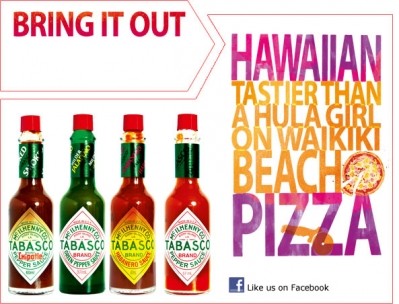Swamp spice

Building a multinational food business in the middle of a sub-tropical swamp may not be everyone's idea of inspired location planning. The logistics are challenging and some of the neighbours – particularly the alligators – can be less than friendly.
But that is to reckon without one of three ingredients behind an iconic global food brand – salt. More than 12,000 years ago, the ingredient drew giant ground sloths, sabre tooth cats and mastodons to Avery Island, south Louisiana.
Today, salt is one of the foundations of Tabasco Original Red Pepper sauce, produced by the McIlhenny Company.
Its vice president operations Troy Romero is a compact man of precise habits. Equally at home on the factory floor or in the surrounding Louisiana backwoods with a hunting bow in hand, Romero likes things to be just so.
Little happens by chance in his world. Whether it's planning the next production run of thousands of Tabasco sauce bottles for a Saudi Arabian client or stalking white-tailed deer, you get the feeling every angle is covered, every possibility accounted for.
Perhaps, it is habit born of necessity. Romero is responsible for the bottling and distribution of all Tabasco sauces and managing the factory that produces them.
Selling to markets worldwide, requires hundreds of different labels.
"We make only 12 different products," he explains in a measured Louisiana drawl. "But because of different labels and different shipper marks, we've got more than 1,800 items that we manufacture for international markets.
"Saudi Arabia will have one code and Mexico another code – or different labels. So, one sauce has many finished item numbers because of the different shipper marks and coding formats."
Tabasco sauces are labelled in 22 languages and dialects, and prepared for shipment to more than 165 countries and territories worldwide.
While that demands detailed bottling line planning, the production process involving just salt, pepper mash and grain vinegar – although long, is relatively straightforward.
Pepper seeds are still grown on Avery Island – as pioneered by company founder Edmund McIlhenny in 1868. But today, the seeds are sent to Latin America for commercial production.
The harvested peppers are mashed and mixed with salt mined from the island.
Stored in white oak barrels – supplied by the bourbon industry – the pepper mash is allowed to ferment and then to age for up to three years in the island warehouse. Before storage the barrel tops are covered with more salt, which acts as a natural barrier to protect their contents.
After ageing, the mash is blended with high-quality distilled vinegar. The product is churned for about four weeks, which is when the vinegar and the mixing impeller break down the solids. This enables the vinegar to take on the aroma, texture, flavour and appearance of the pepper mash.
The product is then milled to remove pulp, seed and skins before bottling after quality assurance checks.
"Two things make our pepper sauce different from competitors' products," says Romero. "First, we age the pepper mash for three years – no one else does that. It ties up an enormous amount of capital.
"Also, many pepper sauce manufacturers grind that sauce up to increase the yield but we remove it. So, Tabasco is a refined product."
Bottling is based on two systems depending on customer location. Exports are manufactured to order, while domestic supply is made to stock.
"International production is just-in-time," says Romero. "In many cases, our customers are ordering relatively low volumes of branded products. So, we get an order and within three weeks it is on a truck ready to be shipped to that international market."
A key focus for international markets is customisation. "Because we are dealing with relatively low volumes, we are able to remain flexible and produce exactly what a particular export market wants, when they want it," he says.
For the domestic market, inventory is always kept in stock throughout the North American supply chain.
Four bottling lines are operated at the plant. One is dedicated mainly to domestic product and one to international, while the two others flex between both.
The major components of the line are the filler, the capper, the labeller and a tamper evident band applicator. There's a case carton machine and then the various case packing machines complete the finished product.
The sauces are supplied in quantities from 30ml sachets to 50 gallon drums. In addition to Original Red Pepper sauce, the portfolio includes: Green Jalapeño, Chipotle, Buffalo Style Hot, Habanero and Sweet and Spicy. Food manufacturers account for about 5% of total sales.
The factory typically works a four-day week. But that is scaled up to five and sometimes six days in advance of high seasonal demand around Thanksgiving and the Christmas holidays.
While Romero won't confirm the plant's capacity, he does disclose that it produces more than 700,000 bottles a day.
To minimise bottling line changeovers, flavours are run in as large groups as possible. "We run a lot of grain sauce and then maybe days of red sauce and then garlic and chipotle and so forth."
Automation helps to run the lines more efficiently and change over more quickly. A constant challenge is balancing the efficiencies of mass production with the demand for customisation.
Cripple your operation
"Typical problems are deciding what automation you need to meet customer demand and developing trends in different markets," says Romero. "For example, in the US there has been a demand for a lower count cases and that would slow down the production lines. So, sometimes you just can't do it because that would cripple your operation. It can be a tough decision to tell a customer you can't fulfil a request."
The workforce is divided into six teams: processing, bottling, maintenance, shipping, receiving and quality assurance.
Two shifts are operated from 7am to 5pm and from 8pm to 7am. A shift meeting is held at about 7am each morning where workers coming off shift can brief their colleagues about any operational problems.
Romero's approach to factory management depends on four principles. "I try to run the factory on a four prong stool – safety, service, quality and cost. I have proved, if I can keep those four key performance measures in place, performing well, then the factory will be performing well in all areas because they all hit the bottom line."
His is a management style forged at PepsiCo's $13bn subsidiary Frito Lay, which employs 48,000 people. Romero spent 10 years with the food giant – working seven years in manufacturing and three years in logistics and – becoming a master trainer for continuous improvement.
"I was selected as one of a team of eight from the south east that did cost-cutting initiatives. So I brought a lot experience of cost cutting, people management and experience of world-class manufacturing systems and distribution systems."
And, when it comes to making cost savings, long experience has taught him that the best place to look is in the detail. "In manufacturing, every now and then, you will come across a big item that makes a big impact. But, more often than not it's a bunch of little things that improve efficiency. It's saving five minutes here on a changeover or saving four minutes there on a flavour rinse. It's those kind of things – not always the big project with all the glamour – often a bunch of little things."
Looking back over his 13 years with the McIlhenny Company, Romero says he is most proud of the savings he has led. "Some of the savings have been about the way we drain the mash, others have been the way we have introduced new machinery in the bottling lines. But we have been able to do that without cutting full-time employees – by balancing capacity with temporary head count and automation."
Romero is full of praise for his managers ("they make my job really easy") and the loyal workforce. About half of the firm's 200 employees live on the island, many of whose parents and grandparents also made Tabasco sauce.
So, perhaps, a salt-rich island surrounded by swamp is not such a bad place after all to build a global food brand. But, when you visit – don't feed the alligators.
Worldwide Tabasco
Ireland: Flavouring native oysters.
France: Steak tartare and Bloody Mary cocktails invented in Harry's Bar, Paris, beloved by Hemmingway.
Canada: Bloody Caesar; Canadian version of Bloody Mary, including vodka, clam and tomato juice.
Guam: This US territory has the world's largest per capita consumption of Tabasco at the equivalent of almost two two-ounce bottles per person each year. Tabasco-flavoured Spam, Hot & Spicy Spam, produced in association with Hormel Foods.
Click here for our exclusive free access video about how globalisation is spicing up the worldwide market for hot foods.














